Purut
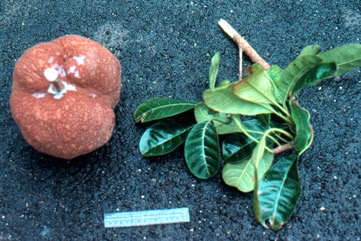
A tropical plant. They occur in central and southern Luzon, Mindoro, Samar and Leyte in the Philippines. The subspecies that occurs in Papua New Guinea occurs from 5 to 1000 m altitude. It occurs in humid forest.
Also known as:
Bangkil, Boboe, Boe, Buah klidang, Bulu ongko, Buratu, Kateh, Kati, Lee khaem, Malanangka, Minggi, Nhego, Pangi, Phayaa raak lueang, Pinggi, Rakwan, Rakwana, Tageva, Tanggajun, Tenggajun
Synonyms
- Artocarpus venesosus Zoll. & Moritzi
- Artocarpus tylophora Miq.
- Artocarpus cerifera Miq.
- Artocarpus reidelii Miq.
- Gymnoartocarpus venenosa (Zoll.) Boerl.
- Gymnartocarpus woodii (Merr.) Merr.
- Parartocarpus beccarianus Baill.
- Parartocarpus involucrata Warb.
- Parartocarpus woodii (Merrill) Merrill
- Parartocarpus triandra (J.J.Smith) J.J.Smith
Edible Portion
- Fruit, Seeds
Where does Purut grow?
Found in: Asia, Brunei, Indochina, Indonesia, Malaysia, Pacific, Papua New Guinea, PNG, Philippines, SE Asia, Solomon Islands, Thailand
Notes: Pakal Parartocarpus venenosus What is the plant like? This is quite a large tree up to 25 metres or more tall. It has milky sap inside. The leaves of the tree are entire on outline and they are arranged on a spiral around the stem The leaf looks like this. The leaves are shiny on both surfaces. The veins are raised under the leaf and sunken on top. The leaf is lighter green underneath. The fruit is large and can be 14cm to 24cm across. It has an irregular shape. The fruit is brown and slightly rough on the outside and with yellow flesh inside. There are quite a few large seeds inside. The seeds are something like breadfruit. The seeds have a yellow layer over them and are white inside. The fruit hand from the branches similarly to breadfruit. As the fruit get ripe they give off as strong sweet smell. This helps people find the fruit in the bush. How are pakal trees grown? Often pakal trees just grow wild in the bush. Flying foxes eat the fruit and they spread the seeds around. Small trees are sometimes transplanted nearer to houses. Where do pakal trees grow? Pakal trees can grow from sea level up to about 1000 metres above sea level. Mostly they are near the sea and are more common on islands. In Papua New Guinea they mostly occur along the North Coast and on islands off the coast. Where did the name come from? Pakal is a Tok Ples name from one of the languages of Manus. It also has other Tok Ples names in other areas of PNG, but doesn’t have a common Tok Pisin name. The scientific name is Parartocarpus venenosus. The word parartocarpus means near or related to the breadfruit group of plants. Pakal or parartocarpus is a fruit tree like breadfruit or Kapaik. Tok ples names. Wodeo Is salang Madang yang Manus pakal New Ireland,Kalau situ New Ireland,Lamekot livu Rabaul lapua How are pakal used? The yellow flesh inside the pakal fruit is eaten cooked. The flesh of the fruit is very dry and therefore it is necessary to have a drink of water afterwards. The seeds are poisonous at least when they are unripe. In some places the seeds are cooked and eaten, but only after they have been soaked in sea water for a few days.
Status: A minor edible fruit moderately common particularly on islands and peninsulas along the north coast of Papua New Guinea.
Growing Purut
Cultivation: It grows wild. It can be grown from seed. Seeds are distributed naturally by flying foxes.
Edible Uses: The seeds are eaten either raw or cooked. The ripe fruit is edible. They are very dry so a drink is needed with them. CAUTION The sap of the tree is often used as an arrow poison. The unripe seeds are poisonous.
Production: The fruit turns very brown on the outside and has a sweet smell when ripe. Fruit production is seasonal.
Nutrition Info
per 100g edible portion| Edible Part | Energy (kcal) | Protein (g) | Iron (mg) | Vitamin A (ug) | Vitamin c (mg) | Zinc (mg) | % Water |
|---|---|---|---|---|---|---|---|
| - | - | - | - | - | - |
Purut Photos

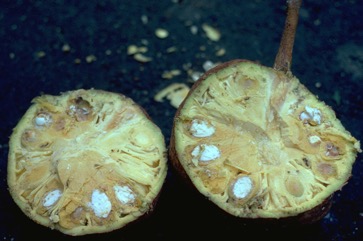
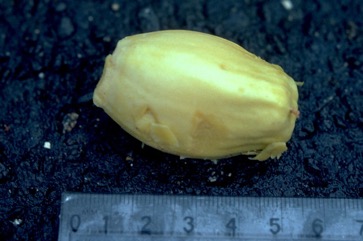
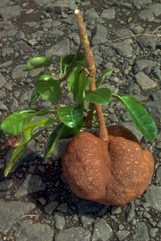
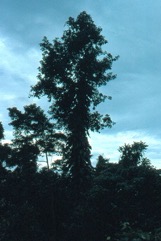
References
Altschul, S.V.R., 1973, Drugs and Foods from Little-known Plants. Notes in Harvard University Herbaria. Harvard Univ. Press. Massachusetts. no. 687
Argent, G et al, nd, Manual of the Larger and More important non Dipterocarp Trees of Central Kalimantan Indonesia. Volume 2 Forest Research Institute, Samarinda, Indonesia. p 440
Borrell, O.W., 1989, An Annotated Checklist of the Flora of Kairiru Island, New Guinea. Marcellin College, Victoria Australia. p 109
Bourke, M., 1995, Edible Indigenous Nuts in Papua New Guinea. In South Pacific Indigenous Nuts. ACIAR Proceedings No 69, Canberra. p 46
French, B.R., 1986, Food Plants of Papua New Guinea, A Compendium. Asia Pacific Science Foundation p 259
French, B.R., 2010, Food Plants of Solomon Islands. A Compendium. Food Plants International Inc. p 177
Brown, W.H., 1920, Wild Food Plants of the Philippines. Bureau of Forestry Bulletin No. 21 Manila. p 40 (As Gymnartocarpus woodii)
Henderson, C.P. and I.R.Hancock, 1988, A Guide to the Useful Plants of the Solomon Islands. Res. Dept. Min of Ag. & Lands. Honiara, Solomon Islands. p 57
Henty, E.E., 1980, Harmful Plants in Papua New Guinea. Botany Bulletin No 12. Division Botany, Lae, Papua New Guinea. p 108, Pl. 40
Lepofsky, D., 1992, Arboriculture in the Mussau Islands, Bismarck Archipelago. Economic Botany, Vol 46, No. 2, pp. 192-211
McClatchey, W. C., 2012, Wild food plants of Remote Oceania. Acta Societatis Botanicorum Poloniae. 81(4):371-380 (As Parartocarpus beccarianus)
Menninger, E.A., 1977, Edible Nuts of the World. Horticultural Books. Florida p 75 (As Gymnartocarpus woodii)
Moon, H. K., et al, 2010, Tropical Tree of Indonesia. Korea Forest Research Institute. p 7
Peekel, P.G., 1984, (Translation E.E.Henty), Flora of the Bismarck Archipelago for Naturalists, Division of Botany, Lae, PNG. p 132, 135
Powell, J.M., Ethnobotany. In Paijmans, K., 1976, New Guinea Vegetation. Australian National University Press. p 111
PROSEA No. 2
Soepadmo, E. and Saw, L. G., 2000, Tree Flora of Sabah and Sarawak. Forestry Malaysia. Volume Three. p 323
Sukarya, D. G., (Ed.) 2013, 3,500 Plant Species of the Botanic Gardens of Indonesia. LIPI p 431
Walter, A. & Sam C., 2002, Fruits of Oceania. ACIAR Monograph No. 85. Canberra. p 281
World Checklist of Useful Plant Species 2020. Royal Botanic Gardens, Kew